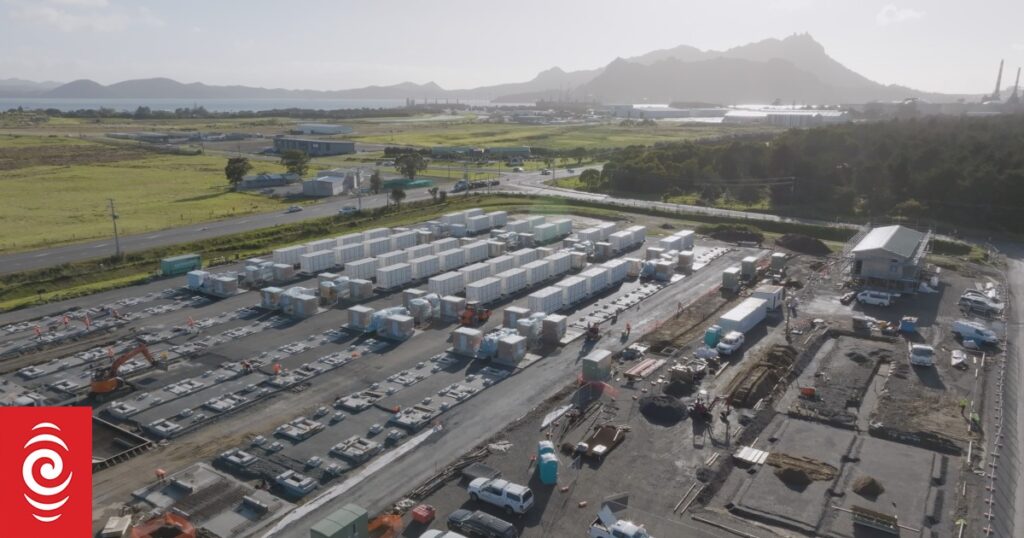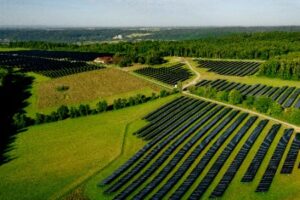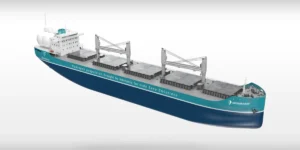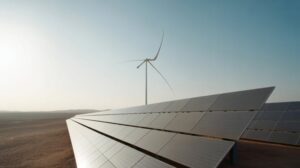Consent granted for large solar power station at Ruakākā in Northland


Meridian’s battery energy storage site (BESS) under construction at Marsden Point.
Photo: Supplied / Meridian
Consent has been granted for a solar power station at Ruakākā in Northland that will produce more than three times the energy of the biggest solar farm currently operating in New Zealand.
If all goes to plan, Meridian’s Ruakākā Solar Farm will start producing power in late 2026.
The 200,000-panel solar farm will be spread over three sites at Marsden Point totalling 172 hectares, with a peak output of 120 megawatts (MW).
Per year it is expected to produce 150-200 gigawatt-hours (GWh), equivalent to the power use of half the homes in Northland.
Currently the biggest solar farms in New Zealand are at Kaitāia in the Far North and Edgecumbe in the Bay of Plenty, both operated by Lodestone Energy and with an expected annual output of 55GWh.
The Ruakākā Solar Farm will be built next to Meridian’s 100MW battery energy storage site, which is due to be completed early next year.
That means solar energy can be stored and released to the national grid when it is most needed, for example during the evenings when domestic power use is high and the sun is not shining.
The battery site will comprise 80 shipping-container-sized lithium-ion batteries, built by French company Saft, and will cover an area equivalent to two rugby fields.
It will be New Zealand’s first large-scale, grid-connected battery site.

Satellite image showing the three sites of Meridian’s planned Ruakākā Solar Farm. The battery site is at top right.
Photo: Supplied / Meridian
Meridian head of renewable development Rebecca Knott said the project would boost Northland’s resilience by using its “phenomenal natural resources” to reduce its reliance on electricity generated in other parts of the country.
The Ruakākā Energy Park, which comprised the solar farm and battery site, was of one of several renewable energy projects Meridian was working on to improve electricity supply security and help create a low-carbon future, she said.
Construction of the solar farm would start by the end of the year, subject to the appeal period and the final decision by the Meridian Board.
The consent was granted last week by the Northland Regional Council, following approval by independent commissioners.
A council spokesman said Meridian had applied for resource consents for earthworks, stormwater diversion and discharges, and vegetation clearance.
Land use consent was granted by the Whangārei District Council in February.
The application, lodged in September 2023 and publicly notified in March, also proposed creating and restoring 19ha of wetlands across the three sites to offset the permanent removal of 17ha of wetlands.

One of 80 container-sized lithium-ion batteries is lowered into place at Meridian’s battery energy storage site (BESS) at Marsden Point.
Photo: Supplied / Meridian
Two submissions supported the proposal and 10 were opposed.
Commissioners David Hill and Sheila Taylor said the electricity generation benefits were not disputed, and the adverse effects – once mitigation and positive effects were taken into account – would be minor.
Objectors have 15 days to appeal the decision.
While Meridian’s proposal is huge by the standards of solar farms in New Zealand, it is still eclipsed by Top Energy’s geothermal power station at Ngāwhā, near Kaikohe.

Aerial view of one of three sites at Marsden Point where Meridian has been granted approval for a 172-hectare solar farm.
Photo: Supplied / Meridian
Last year Ngāwhā produced 444GWh of energy, compared to the 150-200GWh estimate for the Ruakākā Solar Farm.
That is because geothermal power plants operate almost non-stop while solar farms produce energy only when the sun is shining.
Marsden Point used to be the location of two 250MW oil-fired power stations.
Marsden A was built in the 1960s and partly dismantled in the 1990s, but continued to be used until 2007 to support the national grid.
Marsden B was built in the 1970s but never used. It was dismantled and shipped to India in 2012.





